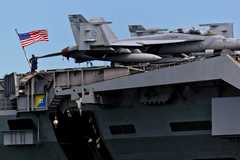US supercarrier / Hong Kong
Fly the flag
Despite the pressures of new technology in its own ranks and a fast-developing Chinese navy sailing into view, the ‘USS George Washington’ continues to rule the Asia-Pacific seas. Monocle climbs aboard the American aircraft carrier.
One hundred thousand tonnes of old-fashioned hard power have just dropped anchor in Hong Kong’s Victoria Harbour, creating a steel-grey island in the wider blue. It is a US Navy supercarrier, one of the world’s most potent military machines; its cargo is a mobile air force of over 70 planes and helicopters, and some 5,500 crew. Alone, it outguns most national air forces.
Meet the USS George Washington, unique among the American fleet of 11 aircraft carriers, and the lead ship of the US Navy’s Carrier Strike Group 5. Unlike its sister ships, which are all based in the States, the GW is forward-deployed to the Asia-Pacific, where it berths at the Japanese port of Yokosuka, 18 miles south of Yokohama. As a result, the ship is the advance party in President Obama’s new “rebalancing” defence strategy in Asia.
Peace-time patrols routinely involve calls at liberty ports such as Hong Kong, where the George Washington appears roughly once a year to fly the flag and give its crew some much-needed shore leave. Right now, the ship’s cavernous hangar bay is hosting what looks like a huge college outing: hundreds of 20-year-olds have swapped uniforms for T-shirts and sweatpants, queuing among parked fighter jets to be ferried into the city for a few hours’ R&R.
They look like they need it. Having experienced the intensity of an exercise off South Korea with the Japanese and Korean Navies, they have been working up to 19 hours a day, seven days a week for six weeks, since leaving Japan. The ship itself, commissioned 20 years ago, predates many of them; however, powered by two nuclear reactors, it doesn’t need a break.
“However you look at it, you’re stuck out in the middle of the ocean with a bunch of guys,” shrugs Airman Raymond Tan, who works as one of the flight deck’s 30 firefighters. “I’m on for 18 hours a day; I get four or five hours’ sleep a night. It all depends on how long the captain wants to keep flying for.” Aviation Structure Mechanic Situ Rui, who maintains the carrier’s f/a-18 fighters, agrees that lengthy deployments can be gruelling. “I love being an airframer,” he says. “Working in the hangar bay is not that bad: 12 hours on, 12 hours off. But you’re on a boat for two to three months, and all you see is water, all you see is sky.”
These young sailors are too numerous for their commanding officer, Captain David A Lausman, to know personally, but he is full of overarching praise as he surveys a flight deck laden with f/a-18s and e-2c surveillance planes (there’s no flying as we’re in Chinese airspace); the latter’s enormous radar dishes resemble piggybacking ufos. The floating fortress he runs sounds impressive, Lausman concedes, when you describe it in terms of tonnage of steel or acreage of the flight deck. “But regardless of all the metal you see here, it’s nothing without the expertise of the crew,” he says, loudly enough for at least a few of them to hear.
The captain details how, with no need to refuel, the ship’s endurance is limited mainly by the need to take on food when supplies run low. “We have pretty much everything we need to sustain ourselves,” he explains, though the long lines of restless crewmen gazing hungrily at Hong Kong suggest this is not altogether true. Lausman cuts a no-nonsense figure, but you can hardly blame him for running a tight ship: in 2008, the Navy sacked a previous captain and his second-in-command after a serious on-board fire caused €60m worth of damage.
In a world of increasingly complex digitised warfare, the ship is certainly not America’s most cutting-edge piece of kit. In contrast with military novelties such as unmanned drones, stealth fighters and cyber-warfare, the concept of flying warplanes off ships – first tried in 1912 – is one of the oldest in the book.

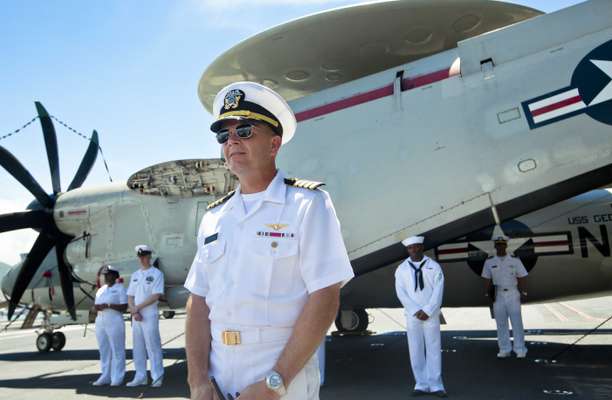
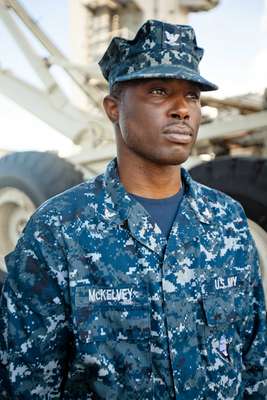
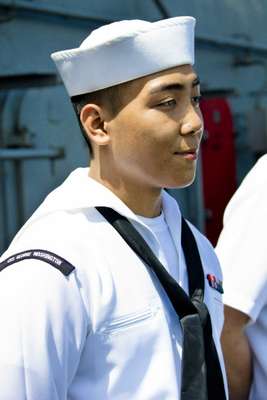

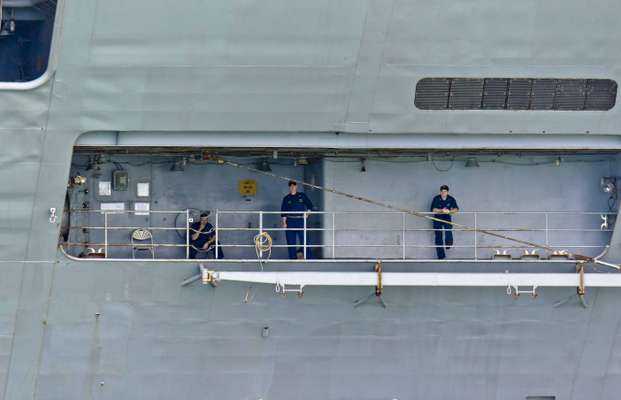
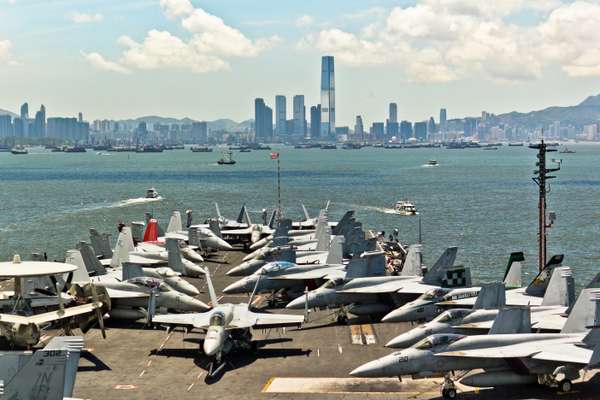
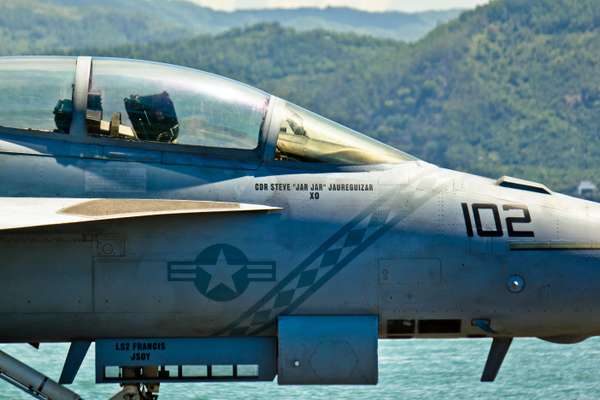
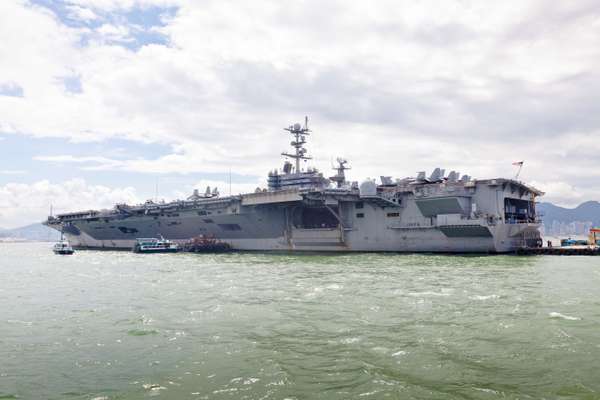
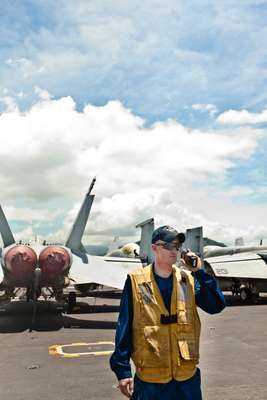
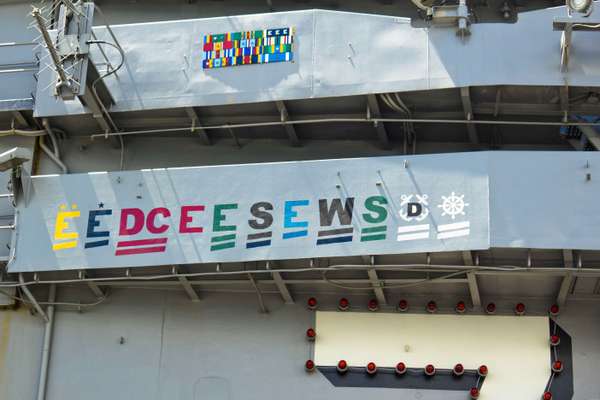
It means that the George Washington has a fittingly analogue feel to it. The navigation bridge is reassuringly free of lights and magic; instead, chunky dials and brass switches, comprehensible scopes and gauges, and big-buttoned keyboards point to the ship’s origins on some Cold War-era drawing board. Navigators pore over paper charts and make jottings in well-thumbed logbooks. A dull, metal steering wheel, smaller than the one in your car, is the helmsman’s unfussy means of driving the boat. Someone on the bridge comments that the man currently at the controls of the supercarrier looks unsuitably fresh-faced. “I wouldn’t let my son drive my car,” quips the officer, “but here we have a 19-year-old driving an $8bn [€6.5bn] carrier.”
Yet for all its 20th-century technology, the GW will remain central to the strategic balance of the Asia-Pacific well into the 21st century. This type of vessel, more than any other military asset, will underwrite America’s status as the world’s dominant military force. Above all, it is still the most awe-inspiring instrument of power projection that military thinkers have been able to devise. It is a symbol of power and, sometimes, of hope, as the ship’s humanitarian efforts in tsunami-hit Japan recently demonstrated. This unchallenged ability to proclaim America’s greatness abroad, combined with Obama’s “pivot” to Asia, will protect the ship from the harsh budget cuts soon to afflict the rest of the US military.
However, there was a moment of uncertainty in 2011 when Pentagon officials, juggling deficits and shifting priorities, mooted the idea of scrapping the George Washington. Its nuclear power plants need refuelling every 25 years or so and this costly process, which will keep the carrier in dock for up to four years, must happen soon. The timing made the GW the most vulnerable of the US’s 10 Nimitz-class flat-tops (the eleventh American carrier, the older USS Enterprise, is on its final tour and already slated to retire later this year).
Then came the reprieve: despite its financial problems, the US Government resolved to maintain its carrier fleet at 11 ships in the long term (the first ship in the new Gerald R. Ford class will replace the Enterprise in 2015). A shrinking carrier force would have sent out all the wrong messages for a country at pains to demonstrate that it is not a waning power.
But these geopolitical considerations feel very distant on a ship that is its own not-so-little world, disciplined by a special set of arcane rules. Dire warnings emblazon the walls: jet blasts and deafening noises are among the primary dangers. Uniform styles and colours denote the wearer’s function to those who know the GW’s sartorial vocabulary; speakers fitted throughout the maze of narrow gangways chatter with mysterious instructions. Ask a crew member what he or she does and they will respond in baffling terms – “at3” perhaps or “e8” – denoting their rating and area of expertise.
Individuals lumped together as “sailors” actually encompass an impressive array of skill sets and career paths, including engineers, chefs, pilots and nuclear technicians. The ship has over 300 crew dedicated to looking after its two nuclear reactors; Electrician’s Mate Senior Chief Andy Chan is one of the most senior, commanding an 80-strong team. “My role is in the bowels of the ship, maintaining power and propulsion,” he explains. “I’d like to say everything works smoothly, but it does break down occasionally.” Not the nuclear bits, he adds quickly, insisting that “the chances of a disaster are slim to none.”
Disaster is more likely to strike from farther afield. The Western Pacific, the George Washington’s beat, is becoming a troubled place. The South China Sea in particular is a fiercely contested space, as the likes of China, the Philippines and Vietnam argue over who owns the many small islands scattered across it. America’s Asian allies, Japan and South Korea, also have territorial disputes with China – and with each other – while North Korea lurks constantly on the radar. The US might not have any direct cause to intervene in many of the region’s potential conflicts, but the possibility of the George Washington and its attendant strike group taking an active interest is usually enough to keep powders dry, even in Asia’s hottest flashpoints.
The GW won’t have these waters to itself forever. Even as she arrived in Hong Kong, somewhere to the north the Chinese Navy’s first aircraft carrier was embarking on its longest sea trials so far, as part of a plan to have three operational carriers in the not-too-distant future. However, stepping aboard this ship – with all of its people, systems, aircraft and logistical intricacies – brings home the complexity of the might that the Chinese are hoping to replicate. The George Washington is scheduled to retire in 2042; one imagines, for all China’s efforts, that it will remain the pre-eminent warship in Asia’s waters even then.
Weaponry
4 squadrons of F/A-18 Super Hornets
1 squadron of EA-18G Growler electronic warfare fighters
1 squadron of E-2C Hawkeye surveillance aircraft
1 squadron of SH-60 Seahawk helicopters
Sea Sparrow anti-ship/anti-aircraft missiles
Rolling Airframe anti-ship/anti-aircraft missiles
Phalanx close-in weapon systems
Carrier group
1 Nimitz-class supercarrier
1 carrier air wing, comprising over 70 aircraft
1-2 Ticonderoga-class guided-missile cruisers
2-3 Arleigh Burke-class guided-missile destroyers
1-2 Los Angeles-class nuclear-attack submarines
1 supply ship
Race for the pacific
In the vast Pacific Ocean, it’s the tiniest places that often end up causing the biggest problems. Numerous countries lay claim to the thousands of islands bestrewing the waters, and friction over who owns what is intensifying.
Though often miles from the countries that claim them, these mainly unpopulated territories enable their owners to claim huge swathes of surrounding ocean complete with valuable fish stocks, as well as any other undersea resources.
They also become symbols of national pride, causing rival claimants to risk conflict even over obscure territories with little material value. As the American military pivots to the Asia-Pacific, it needs to prepare itself for oncoming traffic.
Naval upgrades
Most East Asian nations are significantly enhancing their naval capabilities with a view to safeguarding their prize maritime possessions. In particular, three world-class navies are emerging in Northeast Asia, as China, Japan and South Korea aim to counter each other’s military upgrades.
China covets great-power status and so is emulating the US formula of fielding full-sized aircraft carriers, complete with embarked fighter jets. Its first carrier is currently in testing; three or four Chinese flat-tops should be operational by 2030.
Japan’s pacifist constitution means its navy is spearheaded by a growing fleet of new Hyuga-class helicopter destroyers: mini carriers with up to 11 onboard helicopters. Two of these ships are finished; two larger follow-ons are in the works. Tokyo may be able to fly its new F-35 stealth fighters from the carriers, should the need arise.
The pride of the South Korean navy is a third configuration: its Dokdo-class amphibious assault ships are capable of carrying 10 helicopters, but also hundreds of marines, tanks and other armoured vehicles. One of these ships has already been commissioned, with three more being built. As with Japan’s mini carriers, the Korean assault ships may yet be able to accommodate F-35s, which Seoul is also eyeing.

